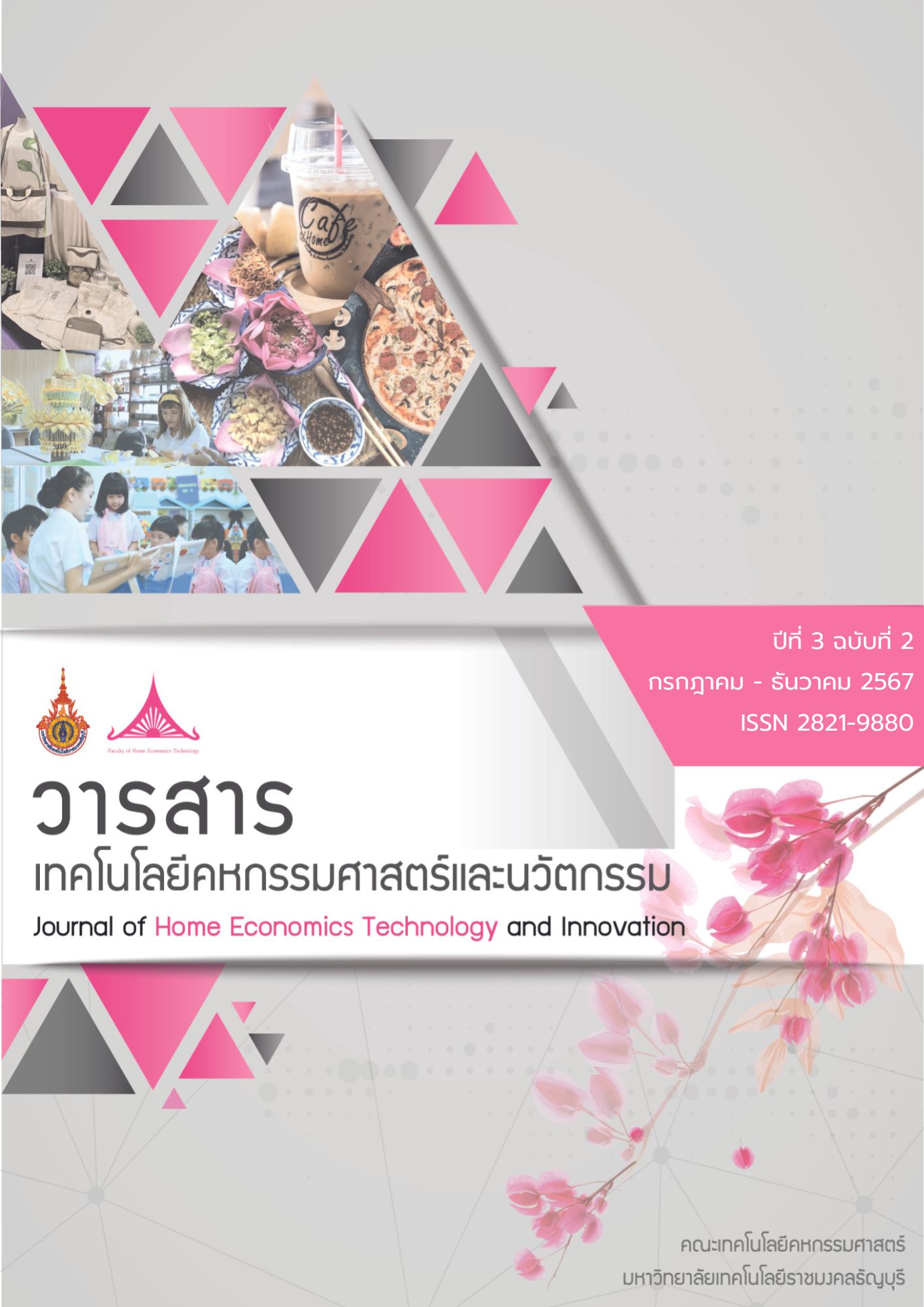Design of Unisex Fashion Clothing using the Creative Batik Technique with Free-Form Patterns from Natural Indigo Dye
Main Article Content
Abstract
This research aimed to determine the optimal wax resist formula and design unisex fashion clothing using creative batik technique with free-form patterns from natural indigo dye. The study population consisted of 100 general participants from Rajamangala University of Technology Thanyaburi. Statistical analysis employed percentage, mean, and standard deviation.
The findings revealed that Formula 1 was optimal for wax resist preparation, comprising 30 grams of rice flour, 0 grams of glutinous rice flour, 32 grams of water, 2 grams of vegetable oil, 23 grams of salt water, and 13 grams of lime water. The resulting paste exhibited finely distributed, uniform cracking patterns. The fabric patterns showed minimal light color gradation with relatively distinct designs. Formula 1 was subsequently used to produce fabric for unisex clothing using creative batik technique with free-form patterns from natural indigo dye. Five design concepts were developed, with Design 4 receiving the highest satisfaction score (mean = 4.67 ± 1.45). This design was selected for prototype development, featuring a Hawaiian collar shirt with 3/4 sleeves adorned with floral cutwork patterns, and loose-fitting flared trousers embellished with floral cutwork at the hem and warm-tone color detailing.
Article Details
Articles published are copyright of the Journal of Home Economics Technology and Innovation. Rajamangala University of Technology Thanyaburi The statements contained in each article in this academic journal are the personal opinions of each author and are not related to Rajamangala University of Technology Thanyaburi and other faculty members at the university in any way Responsibility for all elements of each article belongs to each author. If there is any mistake Each author is solely responsible for his or her own articles.
References
แก้วกัลยา โสตถิสวัสดิ์. (2563). ฤทธิ์ต้านแบคทีเรียของผ้าย้อมคราม. วารสารวิชาการและวิจัย มทร.พระนคร, 15(1), 105-115.
ชุติภาส อุดมสุด. (2560). การศึกษาทัศนคติของกลุ่มชายรักชาย (เกย์) ที่มีผลต่อการเลือกซื้อเสื้อผ้าแบรนด์เนมเพื่อการส่งเสริม สถานะทางสังคม. วิทยานิพนธ์วิทยาศาสตรมหาบัณฑิต สาขาวิชาการบริหารการตลาด คณะพาณิชยศาสตร์และการบัญชี มหาวิทยาลัยธรรมศาสตร์. กรุงเทพมหานคร.
ณัฐสุภา เจริญยิ่งวัฒนา. (2560). อัตลักษณ์การออกแบบแฟชั่นออนไลน์เพื่อเจนเนอเรชั่นวาย. วิทยานิพนธ์ศิลปกรรมศาสตรมหา บัณฑิต สาขาวิชานฤมิตศิลป์ ภาควิชานฤมิตศิลป์ คณะศิลปกรรมศาสตร์ จุฬาลงกรณ์มหาวิทยาลัย. กรุงเทพมหานคร.
ปิยะพร คามภีรภาพพันธ์ และคณะ. (2562). การสร้างมูลค่าเพิ่มให้กับสิ่งทอชุมชนอย่างยั่งยืน. รายงานวิจัยฉบับสมบูรณ์.คณะอุตสาหกรรมสิ่งทอ มหาวิทยาลัยเทคโนโลยีราชมงคลกรุงเทพ. กรุงเทพมหานคร.
โสภาพรรณ ซอหะซัน, สาคร ชลสาคร และรัตนพล มงคลรัตนาสิทธิ์. (2562). การประยุกต์ใช้แป้งเมล็ดขนุนเพื่อทดแทนสารกั้นสีในการเขียนผ้าบาติก. Research on Modern science and Utilizing Technological Innovation Journal (RMUTI Journal), 13(2), 145-158.
อรกานต์ ผดุงวัฒนโรจน์. (2563). นวัตกรรมการสร้างสรรค์ตราสินค้าเครื่องแต่งกายบุรุษด้วยการเพิ่มความเงาของสีเพ้นท์ผ้าจาก ธรรมชาติ สำหรับกลุ่มเจนเดอร์ฟลูอิด (Gender-Fluid) โดยใช้แนวคิดความหลากหลายทางวัฒนธรรมในกรุงเทพมหานคร.วิทยานิพนธ์ศิลปกรรมศาสตรมหาบัณฑิต สาขาวิชานฤมิตศิลป์ ภาควิชานฤมิตศิลป์ คณะศิลปกรรมศาสตร์ จุฬาลงกรณ์มหาวิทยาลัย. กรุงเทพมหานคร.
อุไรวรรณ คำสิงหา และวราภรณ์ บันเล็งลอย. (2566). การพัฒนาเสื้อผ้าชุดสำหรับครอบครัวจากผ้าฝ้ายทอมือ บ้นจันเสน จังหวัดนครสวรรค์. วารสารเทคโนโลยีคหกรรมศาสตร์และนวัตกรรม, 2 (1), 65-75.
Krugri plearn plearn, (2567,10 สิงหาคม). แฟชั่นไร้พรมแดน Unisex Style “เพื่อความเท่าเทียมทางเพศ”.
https://www.krungsri.com/th/plearn-plearn/fashion-unisex-without-borders.
Waymagazine. (2565). “Unisex” มากกว่าแฟชั่นคือความเท่าเทียม. https://waymagazine.org/unisex-fashion/
Chuprina N. V., Paranko N. P., Prasol S. I., Baranova A. I., Kovalchuk M. O and Omelchenko H. V. (2021). Style Direction “Unisex” as a design practice in fashion design. Art and Design, No.1, 9-20.


